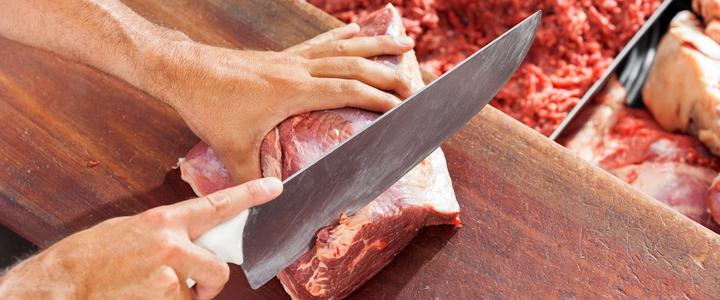The best tools to sharpen your butcher's knife
It's no secret that working with a dull knife can be difficult. It requires more physical effort, costs you time and delivers sub-standard results, as well as putting you at risk of an accident. Like any tool, knives require maintenance to ensure they continue to work effectively, but with so many different options and methods available it can be difficult to know which is best-suited for you. You might find that some techniques are better suited for your butchers knives than others. Here's a quick guide on what to expect, so you can pick the one that works best for you!
The best equipment to use to sharpen your knife
There are a number of different tools on the market which you can use to restore the sharpness and efficiency of your blade. How quick you need the sharpening process to be and the skill and training involved with some methods are some of the factors that can affect the process of choosing the right knife sharpening tool for you.
How to sharpen a knife with a stone
The sharpening stone is a butcher’s tool that has long been in use, and is a staple piece of kit for knife maintenance. Sharpening your knife with a sharpening stone can be tricky and it may take time to establish and perfect your technique. However, once you have managed to develop the skill, sharpening stones can produce some of the best results. Using a stone may not be the fastest method, but when used correctly it will provide you with an even blade that’s flawlessly sharp.

The first step in sharpening a knife with a stone is to ensure that the stone is lightly lubricated. A small amount of water or oil will work as a lubricant to ensure that your knife doesn't get too hot whilst you’re sharpening it. In addition, making sure your stone is clean before you commence is equally important.
This method involves moving the blade back and forth over the stone block at an angle of between 10 and 30 degrees, with light pressure. The optimal angle you should work with is dependent on the length of the blade. A good guide to follow is to aim for an angle of 15 degrees for blades up to 6 inches in length, and between 15 and 30 degrees for longer blades.
It’s also important to bear in mind that sharpening stones aren’t designed for everyday use, but should be used infrequently to make improvements to a significantly dull blade.
How to sharpen a knife with a steel
Many knife sets are sold complete with a steel, so it’s likely that this tool will be the most familiar. However, a common misconception is that these tools are used for knife sharpening, when in fact they are designed to hone your blade. We’ve previously outlined the distinction between sharpening and honing in more detail, but the essential difference is that honing realigns the edge of the blade, which has a positive effect on its performance, and sharpening involves shaving away a light layer on the edge of your blade to make it physically sharper.
Knife steels are ideal for everyday use and are great for giving your knife that extra bit of “edge” through honing. They offer a gentle yet effective method compared to physically shaving and sharpening your knife with a stone, which is why they can be used more regularly to maintain the blade of your knife. Due to the fact that they are mostly used for realignment purposes, knife steels are usually of more use when making improvements to a blade that is only slightly dulled, and are very rarely effective in rescuing a severely dull blade.
Care needs to be taken when sharpening a knife with any tool, but a knife steel is a handheld device that doesn’t afford the stability of a table or work surface, so concentration is key. To use, swipe the blade across the steel, making sure you hone the entire blade from base to tip.

How to sharpen a knife with an electric sharpener
Electric knife sharpeners are praised for their speed, efficiency and ease of use. Because of this, our how-to guide won’t be particularly extensive for this method! Electric knife sharpeners are precision machines that are designed for durability, taking the work off your hands and carrying it out for you. There is no technique to perfect when working with an electric knife sharpener and the machines are usually fairly simple to operate - just plug in and go! These machines offer a faster alternative to sharpening stones and steels, and many take only seconds to deliver a razor-sharp blade.
It’s important to invest in the right tools for the job and, for the methods that require it, to spend time perfecting your technique. However, technique isn’t everything - the quality of your equipment is equally important. Investing in good quality blades and sharpening equipment will save frustrations later down the line, as cheap, poor-quality blades tend to dull rapidly after use and the edges can become dislocated. Quality equipment is essential to a butcher’s arsenal, making your job easier and ensuring you are able to deliver professional results every time.
At Butchers Equipment Warehouse we have plenty of choice for quality knives and sharpening tools from top brands such as F Dick, Victorinox and Dexter Russell, as well as larger equipment including butcher’s blocks and machinery. Our fast & reliable UK delivery is free on orders placed before 12.30pm - so you can rely on your tools to be with you in no time.




